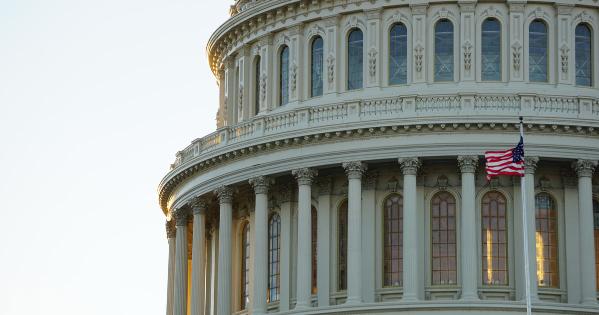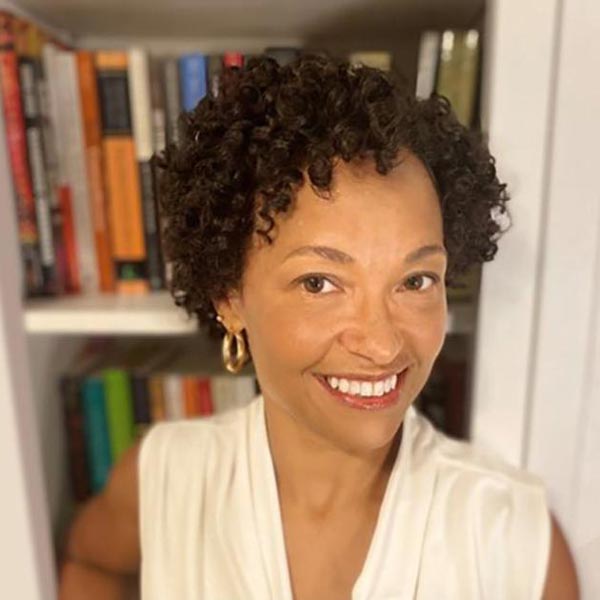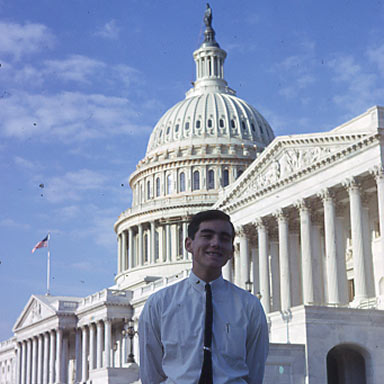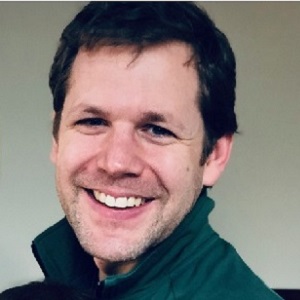The January 6 Insurrection: One Year Later

January 6, 2022 marks a full year since a violent mob attacked and overran the United States Capitol in an attempt to overturn President Trump’s defeat in the 2020 presidential election. On the one-year anniversary of the insurrection, we asked faculty members from across the College of Arts and Sciences to share their thoughts about what happened on that day. Allan Lichtman, Sara Clarke Kaplan, Jack Rasmussen, Nathaniel Herr, Celine-Marie Pascale, Stephanie Grant, and Pamela Nadell provide critical insights into the motivation of rioters and crowds, describe the rise of conspiracy theories and antisemitism across our nation, talk about the fragility of democracy, and mourn the defilement of the Capitol building and all it represents.
Democracy in Peril

During the "golden age" of democracy after World War I, the number of democracies soared from a handful to about 25 nations. Then, by 1943, the number fell to only eleven. In the U.S. today, democracy is likewise slipping away before our eyes. America is now a “flawed,” not a “full” democracy per the Economist’s respected Democracy Index.
The failed attempt to overturn a legitimately conducted election on January 6, 2021, was not a singular event. This insurrection was part of a protracted, still ongoing assault on American democracy, not by the everyday insurrectionists but by privileged elites set upon maintaining power at any cost.
The Big Lie of a stolen presidential election that inspired the Capitol riot endures. A year later, surveys show that a third of Americans think Biden's election was illegitimate. These fellow citizens seem ready to assure that their favored presidential candidate wins in 2024, regardless of the voters’ verdict. They are bolstered by new anti-democratic election laws in several key states that make it easier for partisans to control the outcome of an election.
Americans committed to democracy must show the same fortitude as its opponents. The Justice Department must hold accountable and prosecute those who inspired and instigated the Capitol insurrection, not just their followers. Democrats in the Senate must set aside the obsolete filibuster and pass pending voting rights and electoral reform bills. Democracy is precious, but like all precious things it can be destroyed and must be protected.
Allan J. Lichtman, Distinguished Professor of History and author of 13 Cracks: Repairing American Democracy After Trump (Rowman & Littlefield, 2020)
White Supremacy and Antiblackness in America
 When predominately white insurgents stormed the US Capitol with nooses, Confederate flags, and other symbols of white supremacy, they faced virtually no opposition, experienced fewer than 60 arrests, and had the full-throated support of their President. Public outrage surged on progressive social media. ‘Imagine if they had been Black!’ pundits emailed, texted, posted, and tweeted, pointing yet again to the racialized double standard of policing and punishment in this country. But we need not imagine—we have a point of comparison. On June 1, 2020, nearly 6,000 law enforcement officers and National Guard helicopters were mobilized to descend on Washington, DC in response to a largely peaceful Black Lives Matter protest that never came close to the seats of Federal government. Over 300 people were arrested that night—a small percentage of the protesters jailed, beaten, or tear-gassed during 2020’s long, hot summer of protest.
When predominately white insurgents stormed the US Capitol with nooses, Confederate flags, and other symbols of white supremacy, they faced virtually no opposition, experienced fewer than 60 arrests, and had the full-throated support of their President. Public outrage surged on progressive social media. ‘Imagine if they had been Black!’ pundits emailed, texted, posted, and tweeted, pointing yet again to the racialized double standard of policing and punishment in this country. But we need not imagine—we have a point of comparison. On June 1, 2020, nearly 6,000 law enforcement officers and National Guard helicopters were mobilized to descend on Washington, DC in response to a largely peaceful Black Lives Matter protest that never came close to the seats of Federal government. Over 300 people were arrested that night—a small percentage of the protesters jailed, beaten, or tear-gassed during 2020’s long, hot summer of protest.
For those of us who study and critique white supremacy and antiblackness in the United States, this visceral evidence of America’s ongoing double standard was utterly maddening, yet entirely foreseeable.
For us, it was no surprise that some participants in the January 6th riot were members of the same police departments and National Guard units who fired tear gas canisters and rubber bullets into crowds of antiracist protesters the previous summer; no surprise that some members of those arms of the militarized state deployed against Black citizens were also active members of the white nationalist groups calling for the overturning of the election and the return to a nation made great by white supremacy. We have seen many times before that the tools of US nation-building remain rooted in the histories and ideologies of white supremacy.
Witnessing the occupation of the Capitol, I couldn’t help but recall that this ostensible temple of democracy and freedom was built largely by the coerced labor of captive Black people—the same people whose descendants were excluded from voting for or serving as congressional officeholders for the majority of the Capitol’s existence. I couldn’t stop comparing the ease with which the rioters gained access to the building with Black congresswoman Cynthia McKinney’s 2006 harassment and detention by Capitol Police for failing to wear her lapel pin while visiting her office. In the context of this history, January 6th’s occupation cannot simply be condemned or contained as an aberrational attack on some idealized and deracinated notion of democracy. Rather, it must be understood as a violent conflict between two versions of what Cheryl Harris has dubbed “the settled expectations of whiteness,” in which the expectation of physical safety and political enfranchisement clashed directly with the conviction that white access to and control of the places and levers of power is guaranteed primacy, regardless of electoral outcomes.
Sara Clarke Kaplan, Executive Director, Antiracist Research and Policy Center
Associate Professor of Literature and Critical Race, Gender & Culture Studies
Destruction of Our Nation’s Art

I worked as a page in the US Senate in the summers of 1963 – 67. I loved the traditions of the Senate, the arcane parliamentary procedures, the desks reused by succeeding generations of legislators, the occasional triumphs, as when the Voting Rights Acts of 1964 and 1965 were passed. But, most of all, I loved Constantino Brumidi’s fresco murals in the Capitol rotunda, and especially his designs for the corridors in the Senate wing. It was my first experience of working in a museum. Every day I was surrounded by classical motifs of scrolling vines and mythological and allegorical figures, with flora and fauna native to America painted in oil right on the walls and ceilings surrounding us every day.
The art was so accessible, so fragile and vulnerable, so beautifully symbolic of our democracy.
As I watched on TV the insurrectionists crash their way into the Capitol on January 6, I was shaken, shocked, and depressed that this amazing monument to what was so good in our country would be so defiled. I can only hope what has been wantonly broken can be put back together again.
Jack Rasmussen, Director and Curator, American University Museum at the Katzen Arts Center
Confirmation Bias, Deindividuation in Crowds, and Forceful Emotions

The January 6 capitol riots embodied the increasingly amplified ideological echo chambers that have come to characterize the political life of Americans since the turn of the century. While confirmation bias is nothing new, the recent proliferation of media outlets has supercharged the phenomenon by ensuring we can exclusively select news sources that won’t challenge our existing beliefs. Armed with these convictions, we take to social media, where group polarization emerges when like-minded friends and family members, often unintentionally, nudge each other further and further toward extreme viewpoints.
Bring together a few thousand polarized folks, mix in the deindividuation of the crowd and speakers making forceful appeals to emotion, and the riots aren’t a particularly surprising consequence.
Unfortunately, the events of January 6 don’t appear to be serving as a valuable lesson helping us to come together across party lines to identify and deconstruct some of the toxic processes that got us to this point. Instead, it seems that the investigations and trials will fuel more of the same methods of division that produced the riots in the first place. A year out, we should try not to be fooled by this messaging into mistrusting our fellow Americans. We must remember that extremes, by definition, are rare, and that the vast majority of us share a common identity as Americans striving to make the country better.
Nathaniel R. Herr, Associate Professor, Department of Psychology
Fascism and the Cannibalization of Democratic Institutions

The insurrection of January 6, 2021 belongs to a cultural ecosystem that is centuries old. Scholars from WEB DuBois to Toni Morrison have demonstrated how deeply racism and fascism are intertwined. It is impossible to separate the terror of January 6 from the ideologies of fascism and white supremacy. A study by the University of Chicago Project on Security and Threats found only one meaningful correlation that could explain participation in the violent attack: insurgents were much more likely to come from a county where the proportion of the white population was in decline.
January 6 wasn’t just about scaling the walls and threatening members of Congress. While insurrectionists found support within Congress, far-right extremists infiltrated both military and police forces. The commander of the DC National Guard, Major General William J. Walker, told reporters that the Pentagon had restricted his authority in advance of the siege, leaving him unable to send troops even when he learned that the Capitol was about to be breached. D.C. police officer Michael Fanone, who was badly beaten by insurrectionists, resigned from the police force telling reporters: “Clearly there are some members of our department who feel their oath is to Donald Trump and not to the Constitution.”
Fascism is more than an anti-democratic ideology; it is a strategy for seizing power that cannibalizes democratic institutions. We see it in a year-end report that identifies 262 bills to subvert elections in 41 states. We see it in efforts to ban critical race theory and feminist/gender studies. We see it as well in prolific propaganda—including “stop the steal”— promoted in both social media and news outlets.
To paraphrase Voltaire, those who can make you believe absurdities, can make you commit atrocities. Perhaps the most important way to understand January 6 is as an urgent call to action that people who believe in democracy must answer.
Celine-Marie Pascale, Professor, Department of Sociology
Disgust, Dehumanization, and Fascism

As a figure of speech, the body politic is a slippery term: it means the nation, as in the people of the nation, but also, and at the same time, the sovereign. As in, the body of the sovereign.
Perhaps at no time has this double meaning been more in evidence than on January 6. Although not widely reported, it is known that some of the insurrectionists defecated in halls of Congress and tracked feces wherever they stepped. One need not call one’s Freudian therapist in order to understand that the rioters were enacting our 45th president’s own defilement of democracy, as if one body politic were standing in for the other.
Feces is considered the “universal disgust object” by social scientists because it reminds us of our own mortality, our own inevitable, and putrid, decay. Most of us need not be told that disgust is a problematic feeling to declaim in a democracy – whether by word or deed – because we understand that doing so expresses our superiority over the person, or persons, we are disgusted by. But Trump – and Trumpism – relishes this display of anti-democratic feeling.
Indeed, expressing disgust for other human beings is the first step in dehumanizing them, a gesture necessary to waging war, including especially civil wars – my neighbor is no longer my neighbor – and to building fascist states.
If Trump’s signature political intervention may well be his ability to provoke his opponent’s disgust – a tactic gleefully embraced by his supporters on January 6 — we who love democracy must resist.
Stephanie Grant, Director, MFA Program in Creative Writing; Assistant Professor, Department of Literature
Conspiracy Theories and a Display of Surging Antisemitism

On January 6, 2021 I was glued to the TV, transfixed and horrified by the unfolding of what looked like a coup d’état, the attack on our nation’s Capitol. That it failed and that, a year later, some of those caught on screen have been convicted and sent to jail brings some solace.
But what I also saw that day was yet another display of the antisemitism that has been surging in America and around the world. For American Jews, Charlottesville, Pittsburgh, and Poway have already become metonyms. Charlottesville refers to the white nationalists marching across the University of Virginia campus in August 2017 chanting “Jews will not replace us.” Hoisting tiki torches, they deliberately evoked the specter of the Nazis’ torchlight parades of more than three-quarters a century ago. Pittsburgh and Poway signify the subsequent murders of Jews praying in their synagogues.
Those rioting at the Capitol not only flaunted their contempt for the Constitution and this nation’s laws and lawmakers, but they also proudly waved antisemitism.
Media flashed the photo of the long-haired, scraggly-bearded Robert Keith Packer in a black sweatshirt emblazoned with a skull and crossbones and the words Camp Auschwitz and “work brings freedom,” a rough translation of the German Arbeit Macht Frei displayed at the gate to Auschwitz. What we did not see on camera that day was that on his back the sweatshirt said “staff.”
Others invading the Capitol boasted of their support for Q-Anon. Q-Anon’s followers believe that a cabal of Satanic pedophiles is plotting against President Trump. This conspiracy theory evokes the granddaddy of them all, the notorious forgery the Protocols of the Elders of Zion with its bogus claims of Jews scheming to control the world. Q-Anon’s embrace of antisemitism is widely known. Its supporters shared a cartoon showing a hook-nosed Jew wielding a knife and wading in a river of blood gushing from his attacks on Russians, Poles, Hungarians, and Ukrainians.
In testimony before the House Committee on Veterans Affairs on October 13, 2021, Oren Segal, Vice President of the Center on Extremism of the historic Jewish communal organization the Anti-Defamation League, concluded: “[A]ntisemitism will likely continue to be a central part of the conspiratorial views that fuel right-wing violence.” Sadly, one year later that remains for me one of the lessons of the attack of January 6, 2021.
Pamela Nadell, Patrick Clendenen Chair in Women's and Gender History, Director of Jewish Studies Program, Department of History
